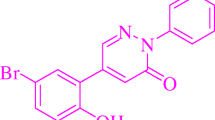Abstract
A novel fluorescence quenching method for the determination of tetracaine hydrochloride (TA·HCl) concentration with some aromatic amino acids as fluorescence probe has been developed. In pH 6.3 acidic medium, tryptophane (Trp), tyrosine (Tyr) or phenylalanine (Phe) can react with tetracaine hydrochloride to form an ion-association complex by electrostatic attraction, aromatic stacking interaction and Van der Waals’ force, which lead to fluorescence quenching of above amino acids. The maximum fluorescence excitation and emission wavelengths of them are located at 278, 274, 258 nm and 354, 306, 285 nm, respectively. The relative fluorescence intensity (F 0/F) is proportional to the TA·HCl concentration in certain range. The linear ranges and detection limits are 1.2–5.0 μg/mL and 0.37 μg/mL for Tyr-TA·HCl system, 1.3–6.0 μg/mL and 0.38 μg/mL for Trp-TA·HCl system, and 1.4–6.0 μg/mL and 0.41 μg/mL for Phe-TA·HCl system. The optimum reaction conditions, influencing factors and the effect of coexisting substances are investigated. And the results show the method has a good selectivity. Judging from the effect of temperature, the Stern-Volmer plots and fluorescence lifetime determination, the quenching of fluorescence of amino acids by TA·HCl is a static quenching process.






Similar content being viewed by others
Reference
Editorial Committee of the Pharmacopoeia of People’s Republic of China (1990) The pharmacopoeia of People’s Republic of China, 2nd edn. People’s Medical Publishing House, Beijing, p 561
Qin MY, Liu SP, Liu ZF, Hu XL (2008) Fluorescence quenching reaction of tetracaine hydrochloride–erythrosin system and its analytical application. Spectrosc Spect Anal 28(2):389–393
Nevado BJJ, Pulgarin MJA, Escudero ROI (2000) Determination of procaine and tetracaine in cocaine samples by variable-angle synchronous fluorimetry. Appl Spectrosc 54(11):1678–1683
Zhang R, Baeyens WRG, Weken GV, Calokerinos AC, Imai K (1995) Chemiluminescence determination of some local anaesthetics. Anal Chim Acta 303:137–142
Pasekova H, Polasek M (2000) Determination of procaine, benzocaine and tetracaine by sequential injection analysis with permanganate-induced chemiluminescence detection. Talanta 52:67–75
Fan J, Wang AJ, Feng SL, Wang JJ (2005) Non-equilibrium determination of metoclopramide and tetracaine hydrochloride by sequential injection spectrophotometry. Talanta 66:236–243
Yang YF (1999) Tetracaine in glassy carbon electrode’s voltammetric behavior and determination. Chin J Anal Chem 27(10):1156–1159
Sun HW, Wen HF, Su M, Li LQ (2009) simultaneous determination Tetracaine and Procaine in blood plasma by Capillary electrophoresis—pyridine ruthenium electrochemical luminescence method. J Instrum Anal 28(2):168–172
Masaru T, Mohammed NI, Zaw T, Katsuya H, Choei W, Tatsuo S, Jun-ichi Y, Toshinori Y, Yukio K (1996) Determination of ester-type local anesthetic drugs (Procaine, Tetracaine, and T-caine) in human serum by wide-bore capillary gas chromatography with nitrogen-phosphorus detection. J Anal Toxicol 20(5):318–322
Grouls RJE, Ackerman EW, Korsten HHM, Hellebrekers LJ, Breimer DD (1997) Partition coefficients(n-octanol/water)of N-butyl-p-aminobenzoate and other local anesthetics measured by reversed-phase high-performance liquid chromatography. J Chromatogr B 694:421–425
Ma M, Kang SY, Zhao Q, Chen B, Yao SZ (2006) Liquid-phase microextraction combined with high-performance liquid chromatography for the determination of local anaesthetics in human urine. J Pharm Biomed Anal 40:128–135
Zhang CH, Zhao Q, Kang SY, Chen B, Ma M, Yao SZ (2006) Determination of local anaesthetics in human plasma by liquid-liquid-liquid microextraction coupled with high performance liquid chromatography. Chin J Anal Chem 34(2):165–168
Wang JS, Lu JR, Zhang LX, Hu YZ (2003) Determination of cetylpyridinium chloride and tetracaine hydrochloride in buccal tablets by RP-HPLC. J Pharm Biomed Anal 32:381–386
Qin WW, Jiao Z, Zhong MK, Shi XJ, Zhang J, Li ZD, Cui XY (2010) Simultaneous determination of procaine, lidocaine, ropivacaine, tetracaine and bupivacaine in human plasma by high-performance liquid chromatography. J Chromatogr B 878:1185–1189
Murtaza R, Jackman HL, Alexander B, Lleshi-Tali A, Winnie AP, Lgic R (2001) Simultaneous determination of mepivacaine, tetracaine, and p-butylaminobenzoic acid by high-performance liquid chromatography. J Pharmacol Toxicol Meth 46(3):131–136
Ohshima T, Takayasu T (1999) Simultaneous determination of local anesthetics including ester-type anesthetics in human plasma and urine by gas chromatography–mass spectrometry with solid-phase extraction. J Chromatogr B 726:185–194
Kudo K, Hino Y, Ikeda N, Inoue H, Takahashi S (2001) Blood concentrations of tetracaine and its metabolite following spinal anesthesia. Forensic Sci Int 116:9–14
Hino Y, Ikeda N, Kudo K, Tsuji A (2000) Sensitive and selective determination of tetracaine and its metabolite in human samples by gas chromatography-mass spectrometry. J Anal Toxicol 24:165–169
Qin MY, Liu SP, Liu ZF, Hu XL (2009) Resonance Rayleigh scattering spectra, non-linear scattering spectra of tetracaine hydrochloride–erythrosin system and its analytical application. Spectrochim Acta Part A 71:2063–2068
Hu XL, Xu DP, Liu ZF, Liu SP, He YQ, Qin MY (2008) Determation some local anesthesia drugs using flow injection—resonance Rayleigh scattering. Chem J Chin Univ 29(10):1963–1968
Qin MY, Liu SP, Liu ZF, Hu XL (2008) Resonance Rayleigh scattering spectra, of tetracaine hydrochloride–erythrosin system and its analytical application. J Southwest Univ (Nat Sci) 30(5):48–51
Guo W, Wu YQ, Zheng LY, Xu LR, Fan XL (2009) Interaction of keyhole limpet hemocyanin with niclosamide and its derivative. Chem J Chin Univ 30(7):1314–1321
Xu JG, Wang ZB (2006) Fluorimetric analysis method, 3rd edn. Science, Beijing, p 65
Lakowicz JR (2006) Principles of Fluorescence spectroscopy, 3rd edn. Springer-Verlag, Berlin Heidelberg, pp 281–282
Ni YN, Wang SS, Kokot S (2010) Spectrometric study of the interaction between Alpinetin and bovine serum albumin using chemometrics approaches. Anal Chim Acta 663(2):139–146
Guan Y, Zhou W, Yao XH, Zhao MP, Li YZ (2006) Determination of nucleic acids based on the fluorescence quenching of Hoechst 33258 at pH 4.5. Anal Chim Acta 570:21–28
Acknowledgements
The authors gratefully acknowledge the financial supports from the National Natural Science Foundation of China (No.20875078) and Chongqing Municipal Key Laboratory on Luminescence and Real-Time Analysis (CSTC, 2006CA8006).
Author information
Authors and Affiliations
Corresponding author
Rights and permissions
About this article
Cite this article
Gan, X., Liu, S., Liu, Z. et al. Determination of Tetracaine Hydrochloride by Fluorescence Quenching Method with Some Aromatic Amino Acids as Probes. J Fluoresc 22, 129–135 (2012). https://doi.org/10.1007/s10895-011-0938-8
Received:
Accepted:
Published:
Issue Date:
DOI: https://doi.org/10.1007/s10895-011-0938-8



